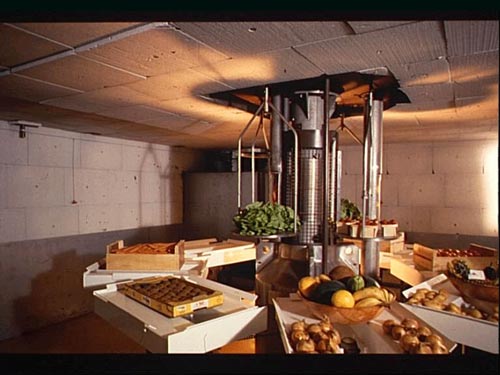Eradicate bacteria, fungi and pests with radiation …
Gamma rays are used industrially to ensure standards of hygiene in the food we consume. Over 20,000 tonnes of produces get sterilized every year in France, either by gamma irradiation or accelerated electrons.

Food ionizer
“Gamma Ionizer” at the ” food ionization Center” installed at Cadarache, in the south of France. This ionizer is intended for experiments. It was designed to treat fresh vegetable products. It is also used for the development of ionization methods on non-food products. It has the size of a small industrial facility.
© CEA
Such types of radiation are an ideal tool for the elimination of microorganisms, bacteria, fungi and parasites at low temperatures and high reliability.
During the process, it is the atoms and molecules that feel the effects of radiations. Unlike what would happen under a neutron irradiation, the atoms nuclei remain untouched. All effects also stop as soon as the irradiation is finished. No radioactive element is produced: from this point of view, the consumption of sterilized food products presents absolutely no danger.
The effects depend on the dose of irradiation expressed in grays (Gy). By moderating the dosage, it is possible to inhibit plant growth (40-100 Gy), sterilize insects (30-200 Gy) or kill them (1,000 to 3,000 Gy). Higher doses are needed to eliminate microbes (1,000 to 4,000 Gy) and pathogenic bacteria (1,000 to 6,000 Gy), or to achieve complete sterilisation (15,000 to 50,000 Gy).
Numerous countries authorise the sale of irradiated produce, whereas others remain firmly opposed, fearing the fallout the association of ‘nuclear’ with ‘food’ could have in the minds of the ill-informed.

Obtaining attractive fruit
A little-known application of radioactivity is the eradication of harmful insects. The technique involves irradiating male larvae to prevent future generations of insects. This was used efficiently in the elimination of the medfly, a fly that was ravaging the fruit- and vegetable-producing countries around the Mediterranean. The method is entirely harmless for humans: gamma rays produce no radioactivity. It was the flies, not the fruit, that were affected.
© AIEA and Biofly/Ilan Misrahi
In another domain, gamma rays can contribute to the visual appeal of fruit and vegetables by eradicating the flies which spoil harvests in sunless countries. Irradiating larvae induces sterility in the adult insects, which eliminates the need for harmful insecticides. The fact that the process is radioactive also poses no danger: the technique is clean and biologically safe.
Other articles on the subject « Applications of Radioactivity »
Inspection and controls
A tool for testing and tune-ups The penetrating property of radiations is commonly used to check [...]
Material Developmnent
Improvements in the quality of industrial products Every day we make use of products that have be[...]
Non Destructive Testing
Control of industrial processes and materials Tracers and radioactive sources are frequently used[...]
Food Preservation
Conservation and preservation of food The effects of radiation on the cells of living or vegetabl[...]
Conservation Effects
A conservation process without additives, non radioactive The biological effects of strong doses [...]
Medfly Eradication
The curse of the medfly and its eradication The Mediterranean flies or Medflies are a dreadful cu[...]
Disinfecting Effects
Getting rid of parasites and germs….. The radiobiological action of radiation leads to damage to [...]
Radioactive Gauges
Instruments for industrial process control In order to be peforming and efficient; modern industr[...]
Sources in Industry
A wide variety of applications Most radioelements in radioactive sources are extracted from small[...]
Various Applications
Because of the fears it inspires, radioactivity is considered in the collective unconscious as ho[...]